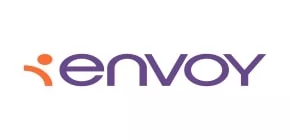Global rotational programs can serve as a powerful employee development and retention tool when implemented effectively
Attracting and retaining the next generation of top talent is becoming a key priority for talent acquisition and human resources teams, and research shows that this talent pool is overwhelmingly interested in a more global experience. Data cited in Envoy INSIGHTS' Global Talent Imperative Report shows that 71% of millennials want and expect overseas assignments.
Employers are meeting these demands while filling key roles at their organization through the use of global rotational programs, a series of strategic international assignments where employees transfer between a company's international office locations. A win for both employees and employers, global rotational assignments help companies retain talent, upskill their workforce and stay competitive.
Four practices to build a thoughtful and scalable global rotational program
Define program goals
Global rotational programs can serve numerous purposes: staffing overseas projects or new office locations, spreading culture and skills across a multinational workforce, or rewarding high-potential employees with new opportunities for development. Obtain feedback from hiring managers and leadership in your home country and potential destination offices to understand whether employees are most in need of professional development, skills training, engagement or potentially all three. Identifying where an organization's greatest needs are can help HR teams design their program accordingly.
When determining employee eligibility for the program, keep these goals top of mind while also weighing an employee's tenure, educational background and specialized skills. Although many rotation programs have historically been reserved for senior executives, there's value in making rotational assignments accessible at every level and job function to reap even more benefits and turn your program into a perk and a talent acquisition driver.
Plan strategically
When determining the structure for global rotational assignments, HR teams should also keep in mind that longer isn't always better. Short and more personalized placements (between 30 to 90 days) can still strongly engage employees while also allowing for simplified administration and compliance, cutting down costs and reducing disruption to teams.
Depending on the size and geographical scope of a company, there may be a myriad of destination countries to choose from, but it's important to select markets carefully. Consider which international offices are best equipped to support the needs of international assignees, and select countries with efficient immigration and tax requirements to reduce bottlenecks or delays. Global rotational programs should also be inclusive and mindful of international contexts. Specialized policies and protections can help employers safeguard female, minority, LGBTQ+ and other marginalized populations while traveling abroad.
Emphasize employee experience and autonomy
HR teams will need to choose the right providers for relocation, immigration and other services. Capable partners with reliable technology not only ensure scalable administration, but also streamline the many logistical and legal processes involved with traveling abroad for employees and helps keep them from feeling intimidated or overwhelmed. Identify these partners early and make sure they are aligned with each other and your team during the implementation process.
Once these essentials are put into place, select program participants and start the process to secure work authorization early. In addition, find ways to strike a balance between keeping international assignees engaged with their home office and giving them the autonomy to design their own experience while abroad.
Develop measurement standards
Evaluating general employee performance and retention rates of program participants is a great way to get broader feedback on the effectiveness of your rotation program, but consider also working with hiring managers to develop specialized program objectives for individual employees to measure results on an even more granular level.
After an assignment is completed, HR and hiring managers can work together to assess whether an employee met these predefined development or training objectives and if they were easily measurable or need to be redefined in the future.
The content of this article is intended to provide a general guide to the subject matter. Specialist advice should be sought about your specific circumstances.

